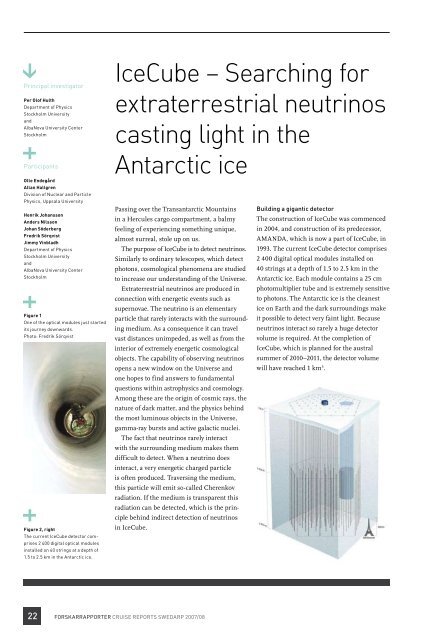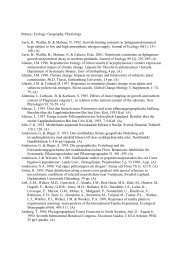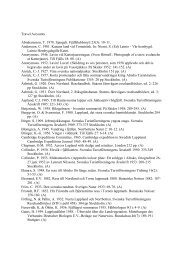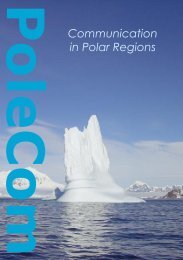Ladda ner årsbok 2008 (6,5 MB) - Polarforskningssekretariatet
Ladda ner årsbok 2008 (6,5 MB) - Polarforskningssekretariatet
Ladda ner årsbok 2008 (6,5 MB) - Polarforskningssekretariatet
You also want an ePaper? Increase the reach of your titles
YUMPU automatically turns print PDFs into web optimized ePapers that Google loves.
Principal investigator<br />
Per Olof hulth<br />
Department of Physics<br />
Stockholm University<br />
and<br />
AlbaNova University Center<br />
Stockholm<br />
Participants<br />
Olle Endegård<br />
Allan hallgren<br />
Division of Nuclear and Particle<br />
Physics, Uppsala University<br />
henrik Johansson<br />
Anders nilsson<br />
Johan söderberg<br />
Fredrik sörqvist<br />
Jimmy Vinbladh<br />
Department of Physics<br />
Stockholm University<br />
and<br />
AlbaNova University Center<br />
Stockholm<br />
Figure 1<br />
one of the optical modules just started<br />
its journey downwards.<br />
Photo: Fredrik Sörqvist<br />
Figure 2, right<br />
The current IceCube detector comprises<br />
2 400 digital optical modules<br />
installed on 40 strings at a depth of<br />
1.5 to 2.5 km in the Antarctic ice.<br />
IceCube – searching for<br />
extraterrestrial neutrinos<br />
casting light in the<br />
antarctic ice<br />
Passing over the Transantarctic Mountains<br />
in a Hercules cargo compartment, a balmy<br />
feeling of experiencing something unique,<br />
almost surreal, stole up on us.<br />
The purpose of IceCube is to detect neutrinos.<br />
Similarly to ordinary telescopes, which detect<br />
photons, cosmological phenomena are studied<br />
to increase our understanding of the Universe.<br />
Extraterrestrial neutrinos are produced in<br />
connection with e<strong>ner</strong>getic events such as<br />
supernovae. The neutrino is an elementary<br />
particle that rarely interacts with the surrounding<br />
medium. As a consequence it can travel<br />
vast distances unimpeded, as well as from the<br />
interior of extremely e<strong>ner</strong>getic cosmological<br />
objects. The capability of observing neutrinos<br />
opens a new window on the Universe and<br />
one hopes to find answers to fundamental<br />
questions within astrophysics and cosmology.<br />
Among these are the origin of cosmic rays, the<br />
nature of dark matter, and the physics behind<br />
the most luminous objects in the Universe,<br />
gamma-ray bursts and active galactic nuclei.<br />
The fact that neutrinos rarely interact<br />
with the surrounding medium makes them<br />
difficult to detect. When a neutrino does<br />
interact, a very e<strong>ner</strong>getic charged particle<br />
is often produced. Traversing the medium,<br />
this particle will emit so-called Cherenkov<br />
radiation. If the medium is transparent this<br />
radiation can be detected, which is the principle<br />
behind indirect detection of neutrinos<br />
in IceCube.<br />
22 FoRSKARRAPPoRTER CRUISE REPoRTS SWEDARP 2007/08<br />
Building a gigantic detector<br />
The construction of IceCube was commenced<br />
in 2004, and construction of its predecessor,<br />
AMANDA, which is now a part of IceCube, in<br />
1993. The current IceCube detector comprises<br />
2 400 digital optical modules installed on<br />
40 strings at a depth of 1.5 to 2.5 km in the<br />
Antarctic ice. Each module contains a 25 cm<br />
photomultiplier tube and is extremely sensitive<br />
to photons. The Antarctic ice is the cleanest<br />
ice on Earth and the dark surroundings make<br />
it possible to detect very faint light. Because<br />
neutrinos interact so rarely a huge detector<br />
volume is required. At the completion of<br />
IceCube, which is planned for the austral<br />
summer of 2010–2011, the detector volume<br />
will have reached 1 km3 .








